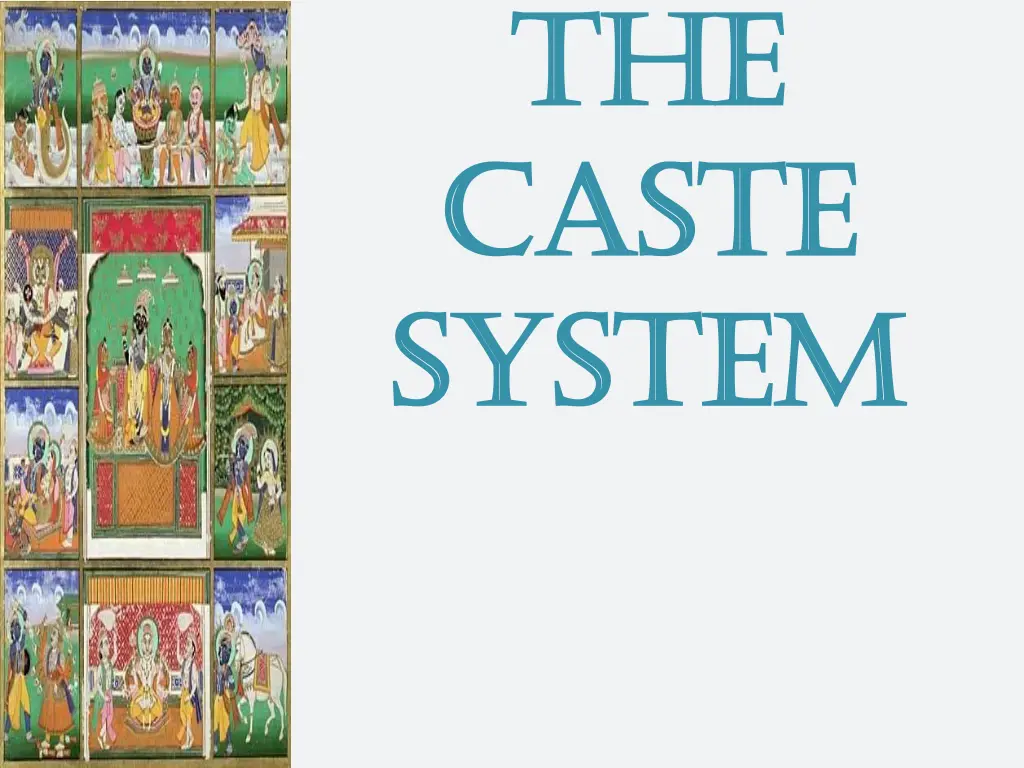
Understanding the Caste System in India
Explore the origins and structure of the caste system in India, a societal division based on occupation and ancestry. Learn about the Brahmins, Kshatriyas, Vaisyas, and more, and how this system influenced social roles and interactions. Discover the historical context and implications of this ancient societal structure.
Download Presentation

Please find below an Image/Link to download the presentation.
The content on the website is provided AS IS for your information and personal use only. It may not be sold, licensed, or shared on other websites without obtaining consent from the author. If you encounter any issues during the download, it is possible that the publisher has removed the file from their server.
You are allowed to download the files provided on this website for personal or commercial use, subject to the condition that they are used lawfully. All files are the property of their respective owners.
The content on the website is provided AS IS for your information and personal use only. It may not be sold, licensed, or shared on other websites without obtaining consent from the author.
E N D
Presentation Transcript
The The Caste Caste System System
The Caste System Caste System So, the Caste System Caste System began in India after the Aryans invaded and established their own rules for governing the society. The Aryans did not permit marriages between their own people and people of the cultures they conquered. This was very different from the Romans, who encouraged the people they conquered and the soldiers to marry.
The Caste System Caste System A caste is a division of society based on occupation and family ancestry. The caste system was based on birth. People inherited caste from their parents and passed it on to their children. Each caste had its own specific place in society. They socialized, ate, married, worked, and worshipped within their own caste. They would never consider marrying or working outside their caste.
The Caste System Caste System The caste system, then, was based upon idea that people are different, so they should have different roles. From 1000 to 500 BC, four classes of people emerged in India. Really there are 5 groups, however the untouchables are considered so low that they aren t even counted.
The castes upper class
BRAHMAN BRAHMAN Priestly Class (Priests) Study the Vedas (sacred scriptures/texts) Perform rituals for themselves & others Men who are between the gods & people To have excellent behavior Pursuit of divine knowledge Preserve the traditions of Hinduism
KSHATRIYAS KSHATRIYAS warrior class protected the people give gifts to the Brahmins offer sacrifices to gods & ancestors study the Vedas dispense justice. protect the caste system & social order
The castes middle class
VAISYAS VAISYAS They are the merchant and peasant classes, who are expected to tend cattle, offer sacrifices, study the Vedas, trade, lend money and farm the land. They had the right to perform and participate in certain Vedic rituals but they were not allowed to marry women of higher castes.
The castes lowest classes
SUDRAS SUDRAS The are the laboring class, whose only duty is to serve the other three castes. They were not required to observe any Vedic rituals. They were not allowed to study the Vedas or even hear the sacred chants. They were not allowed to eat food in the company of higher castes or marry their women.
SUDRAS SUDRAS HARIJAN also called HARIJAN also called Untouchables Untouchables The lowest of the sudras were called harijan or the untouchables. They were outside of the caste system because of their religious practices, rites and unclean habits. In ancient times they were not allowed to enter a village or city during day time or walk in the same street where men of other castes walked.
SUDRAS SUDRAS HARIJAN also called HARIJAN also called Untouchables Untouchables Even their shadow was considered impure and seeing an untouchable was considered bad luck. So they lived mostly on the edges of society, unknown and uncared for, and working in graveyards or as hunters, butchers and professional cleaners of human waste.
Varna Varna Social Social Hierarchy Hierarchy Brahmins Brahmins Kshatriyas Kshatriyas Vaishyas Vaishyas Shudras Shudras Outcasts [Harijan] Untouchables
Varna Varna WHO IS WHO IS Brahmins The mouth? Kshatriyas The arms? The legs? Vaishyas The feet? Shudras
